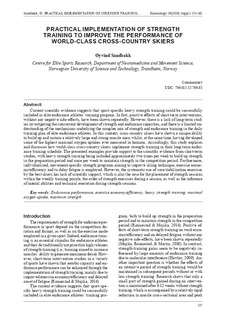| dc.contributor.author | Sandbakk, Øyvind | |
| dc.date.accessioned | 2019-04-25T07:16:22Z | |
| dc.date.available | 2019-04-25T07:16:22Z | |
| dc.date.created | 2018-11-24T19:47:43Z | |
| dc.date.issued | 2018 | |
| dc.identifier.citation | Kinesiology. 2018, 50 155-162. | nb_NO |
| dc.identifier.issn | 1331-1441 | |
| dc.identifier.uri | http://hdl.handle.net/11250/2595349 | |
| dc.description.abstract | Current scientific evidence suggests that sport-specific heavy strength training could be successfully included in elite endurance athletes’ training program. In fact, positive effects of short-term interventions, without any negative side-effects, have been shown repeatedly. However, there is a lack of long-term studies investigating the concurrent development of strength and endurance capacities, and there is a limited understanding of the mechanisms underlying the complex mix of strength and endurance training in the daily training plan of elite endurance athletes. In this context, cross-country skiers have shown a unique ability to build up and sustain a relatively large and strong muscle mass whilst, at the same time, having developed some of the highest maximal oxygen uptakes ever measured in humans. Accordingly, this study explores and discusses how world-class cross-country skiers implement strength training in their long-term endurance training schedule. The presented examples provide support to the scientific evidence from short-term studies, with heavy strength training being included approximately two times per week to build up strength in the preparation period and once per week to maintain strength in the competition period. Furthermore, individualized, movement-specific strength programs aiming to improve skiing technique, exercise economy/efficiency and to delay fatigue is employed. However, the systematic use of core/stabilization exercises by the best skiers has lack of scientific support, which is also the case for the placement of strength sessions within the weekly training puzzle, the order of strength exercises during a session, as well as the influence of mental abilities and technical execution during strength sessions. | nb_NO |
| dc.language.iso | eng | nb_NO |
| dc.publisher | University of Zagreb, Faculty of Kinesiology | nb_NO |
| dc.rights | Navngivelse-Ikkekommersiell 4.0 Internasjonal | * |
| dc.rights.uri | http://creativecommons.org/licenses/by-nc/4.0/deed.no | * |
| dc.title | Practical implementation of strength training to improve the performance of world-class cross-country skiers | nb_NO |
| dc.type | Journal article | nb_NO |
| dc.type | Peer reviewed | nb_NO |
| dc.description.version | publishedVersion | nb_NO |
| dc.source.pagenumber | 155-162 | nb_NO |
| dc.source.volume | 50 | nb_NO |
| dc.source.journal | Kinesiology | nb_NO |
| dc.identifier.cristin | 1634577 | |
| dc.description.localcode | Copyright (c) 2018 Kinesiology. This work is licensed under a Creative Commons Attribution-NonCommercial 4.0 International License. | nb_NO |
| cristin.unitcode | 194,65,30,0 | |
| cristin.unitname | Institutt for nevromedisin og bevegelsesvitenskap | |
| cristin.ispublished | true | |
| cristin.fulltext | postprint | |
| cristin.qualitycode | 1 | |

